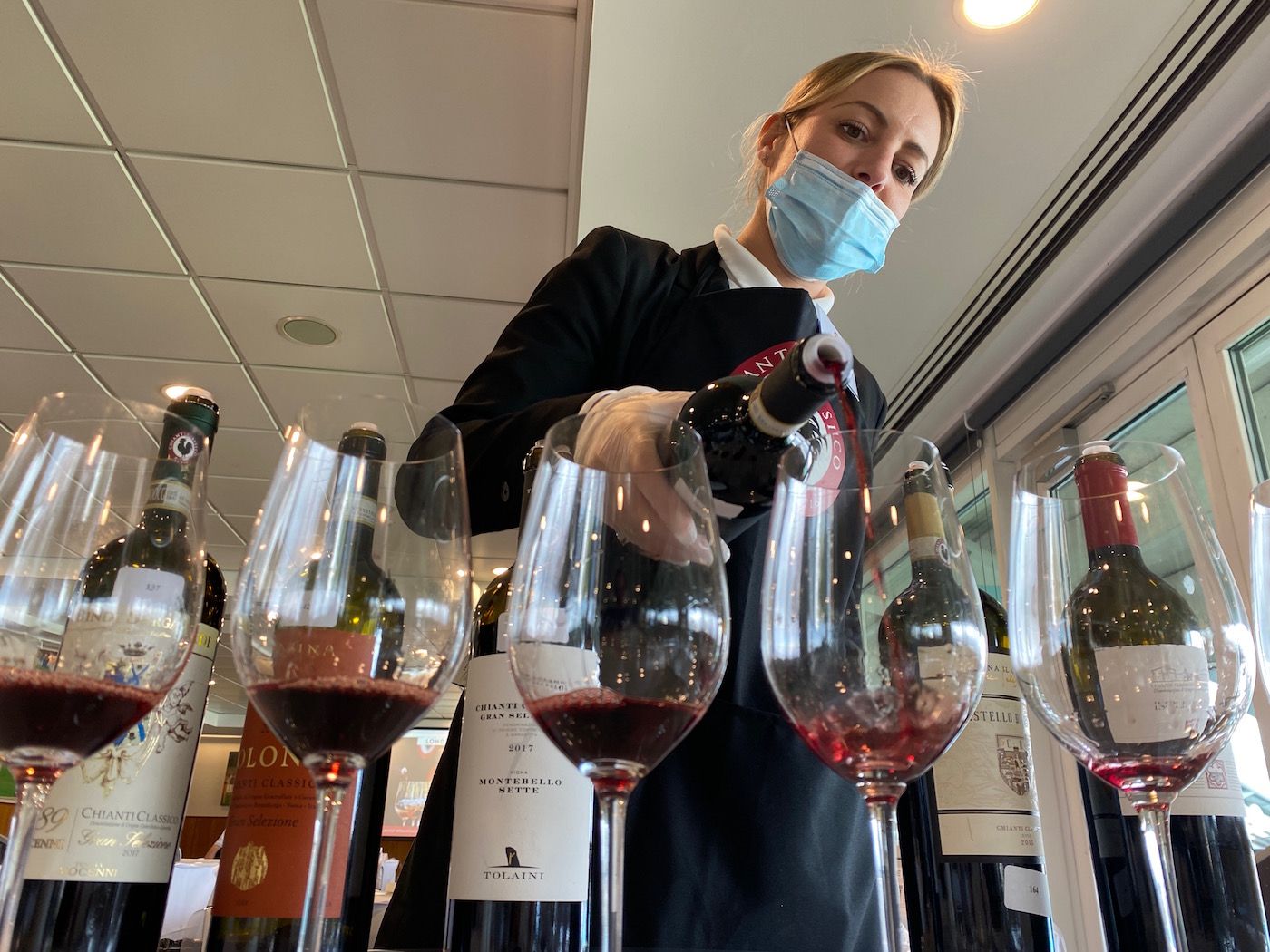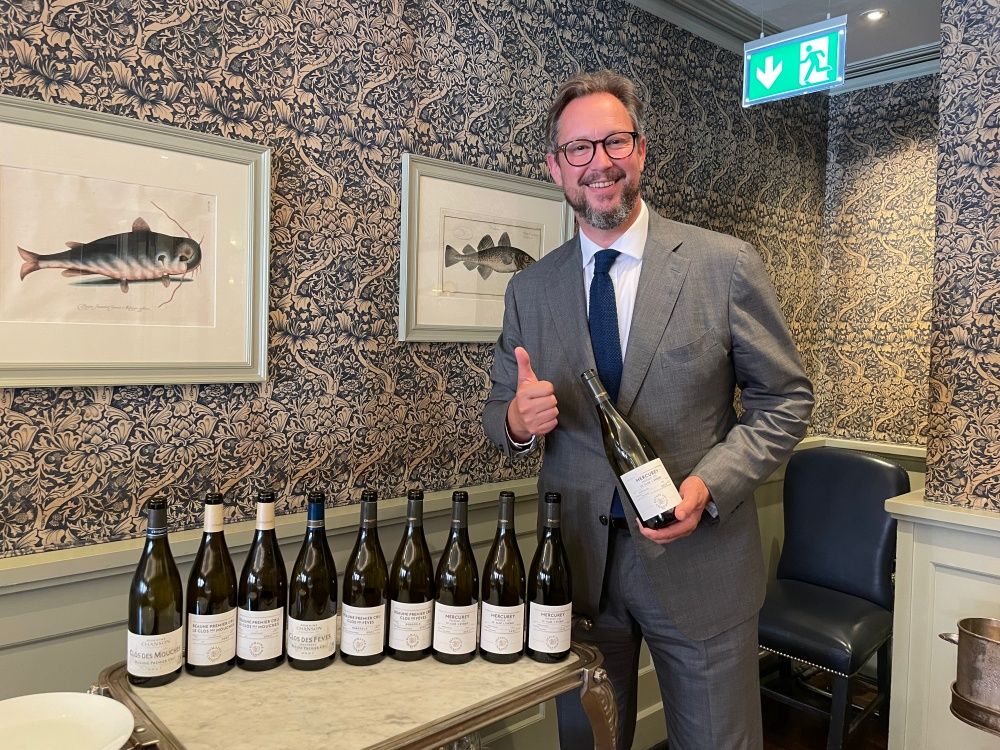“Chianti lost its link to where it came from. It’s been an uphill battle since 1924 when Chianti Classico was born as a distinct region. Rather like Prosecco it became wine – rather than wine from a region,” Count Sebastiano Caponi says.
Ambition was the hallmark of the annual Consorzio Vino Chianti Classico tastings this year with physical events held across the developed world on May 20-21. New York, Chicago, Tokyo and um, Monaco all hosted tastings, with the last suggesting the DOCG wants those living in Somerset Maugham’s “sunny place for shady people,” to turn their high-end palates towards Sangiovese. Those in Florence found themselves in the sunny frescoed cloister of Santa Maria Novella, about as good as it gets for a tasting environment.
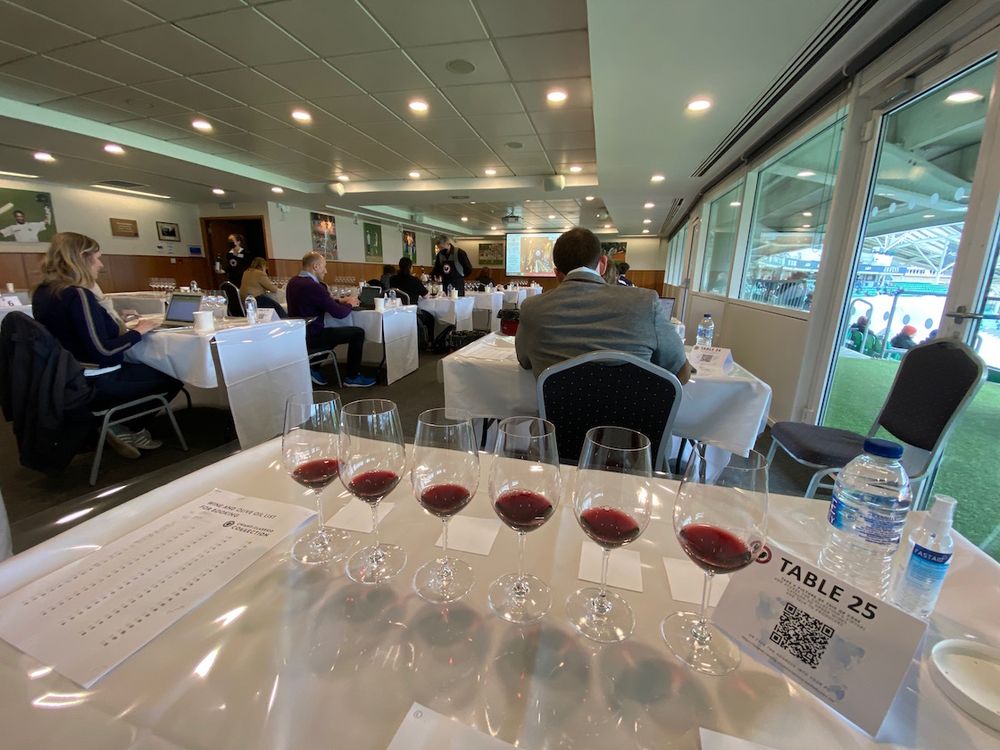
Consorzio Vino Chianti Classico tasting, London May 2021
Us Brits had to put up with an apocalyptically rainy Oval in what was, however, a beautifully organised event, with sommeliers serving individual tables, as Consorzio president and Fontodi head, Giovanni Manetti, smiled down benignly from a video screen.
Over 170 Chianti Classicos – ranging from the yet-to-be-released Annata 2019 through to 2016, Riserva 2018-16 and Gran Selezione 2017-2015 – were shown. That’s a lot of wine but quality was very high, confirming this DOCG’s recent reputation as one of the most improved, with many of the 2019s already good to go; some previous vintages have been simply too tannic for immediate enjoyment, with two years not unusual for a decent softening. Much as I appreciate Sangiovese though, it was hard to escape a creeping feeling of ubiquity – not on the scale say, of Ribera del Duero but enough to eventually tire of the red cherry and dry tannins that are the hallmark of the DOCG. Time to dig deeper, I thought.
One of the many changes ongoing in Chianti Classico, following on from the introduction of the Gran Selezione category, is the move towards regionality. Increasingly producers are putting the name of one of the nine communes on their wines to show place and point of difference from producers in other communes. Obviously we are a long way from being able to distinguish between an Annata made from grapes grown in Greve in Chianti from one say, in Castellina in Chianti: differing soil types, altitude and the impact of winemaker technique being just three of the other factors that come into play. But I thought it would be interesting to Zoom in on four very different producers from communes in the DOCG to see what this might say about Chianti Classico in 2021.
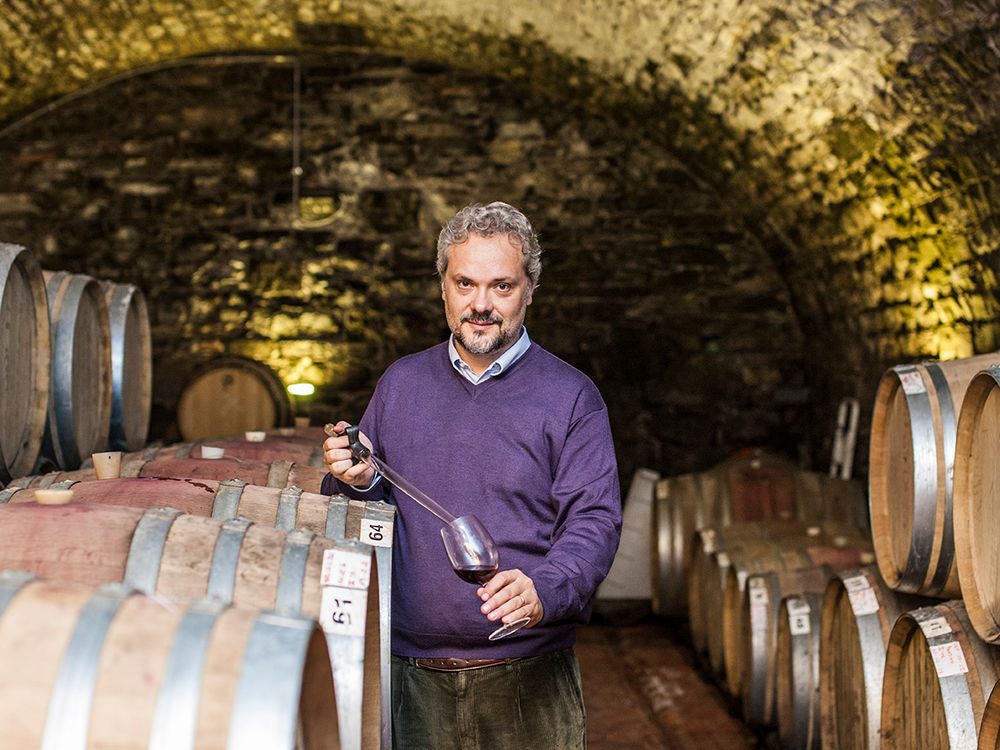
Count Sebastiano Capon at Villa Calcinaia
Villa Calcinaia in the Greve In Chianti region
Starting in the northern part, in Florence province, in Greve In Chianti and Villa Calcinaia, I meet Count Sebastiano Capponi, whose family has owned this estate for generations. He admits the last year has been dreadful with restaurants and hotels really only able to operate for four out of the last 12 months, although exports, particularly to the US, have held up, and he is hopeful things will return to near normal.
Of more concern is the sense that, until recently at least, Chianti Classico seems to have lost its way, more focused on volume than quality, prompting confusion between the Chianti Classico region – which produces typically 35m bottles a year – and Chianti, which makes 110m bottles at prices typically 40% less.
“Italians often don’t think for the long term. To my mind there is a big difference between the beverage market and the fine wine market, and Chianti lost its link to where it came from. It’s been an uphill battle since 1924 when Chianti Classico was born as a distinct region. Rather like Prosecco it became wine rather than wine from a region,” he says.
Capponi argues that to move fully to the fine wine segment Chianti Classico producers need to “add content” with Sangiovese more fully reflecting the character of where it is grown. He sees the move towards using increasing ratios of Sangiovese as very positive.
“I think the era of planting international varieties was quite important because you need to make mistakes to discover your real identity, who you really are.”
Capponi is certainly practising what he preaches. Villa Calcinia produces typically 50,000 bottles a year of which just 5000 are Gran Selezione but he makes three of these, each one using grapes grown in vineyards just a few hundred metres apart, so each one is a full and proper expression of each terroir. All are vinified the same way.
“We need to create our own echelon and moving towards more clearly distinct boroughs or communes is the way to go. But, as with Burgundy, it will still be hard to determine which region a wine comes from, particularly with the bigger boroughs. Smaller regions like Lamole will find it easier,” he argues.
In the meantime the focus is on the wines, and getting the acidity/tannin profile right so they are approachable but also have elegance and can age well – something he feels should be the essence of Chianti Classico.
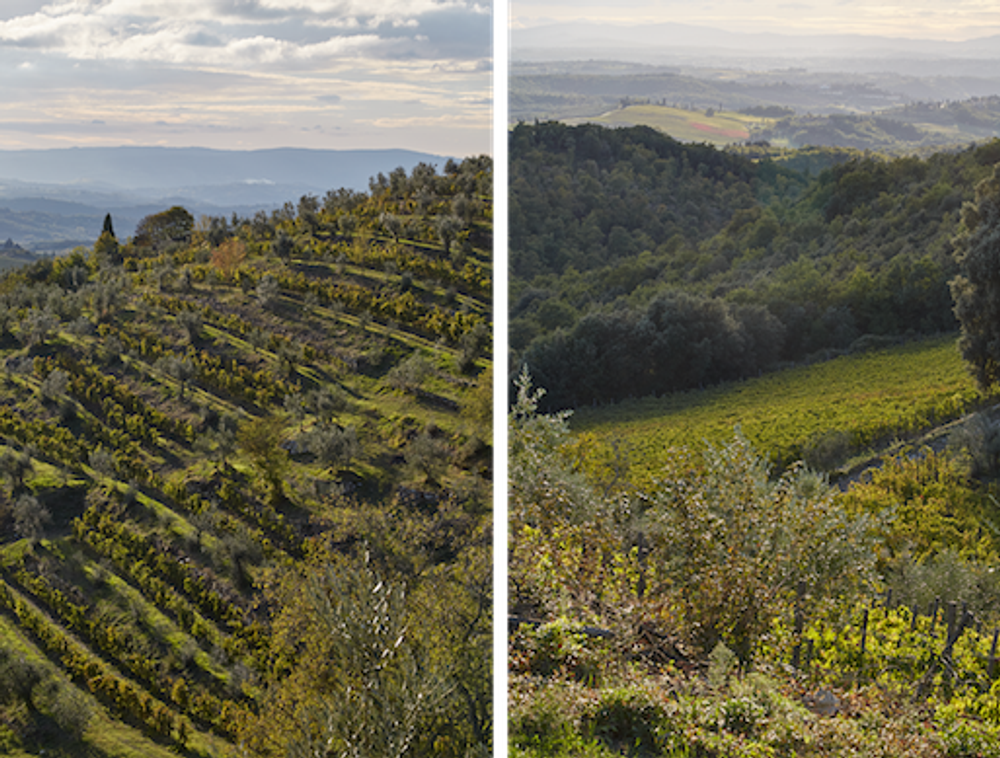
Castagnoli in the Castellina In Chianti region
Moving southwest, to Castellina In Chianti, I reached Tim Schefenacker of Castagnoli, a relatively small producer – typically around 40,000 bottles – imported into the UK by Lea and Sandeman. He also admits Covid has battered distribution channels with sales down across the board but says the winery’s small size meant it wasn’t difficult to maintain social distancing during the growing and winemaking process last year.
The bigger and more enduring problem is that – like Caponi – he thinks many consumers are still challenged by Chianti Classico, not just because of confusion with the wider Chianti region but because of the difficulties in distinguishing between the nine communes.
“We’re in Castellina In Chianti as it says on our bottles but as a commune it doesn’t particularly stand out. People are trying to make things clearer – for example Walter Speller has selected his own Grand Cru wineries – but it’s still very difficult to navigate through the hundreds of producers. Ideally we should move towards a Burgundy style Cru system so consumers can understand better, but it’s hard to get there; Italians are not like French people.”
In terms of style, he says the region doesn’t necessarily produce full-bodied wines but he, like other producers, has pulled up international varieties like Syrah and replaced them with Sangiovese, to the extent that since 2017 all three categories of his wine – Annata, Riserva and Gran Selezione – are 100% Sangiovese.
“The grape is very distinctive but also hard to manage, and we have to select different vineyard parcels to be sure colour, body and polyphenols are as they should be, with low ph and lots of freshness.”
Schefenacker says the motivation came from the market, with consumers increasingly wanting “authentic” wines with a strong sense of place.
“God gave us Sangiovese so we plan to work with it in a way that reflects this region,” he says.
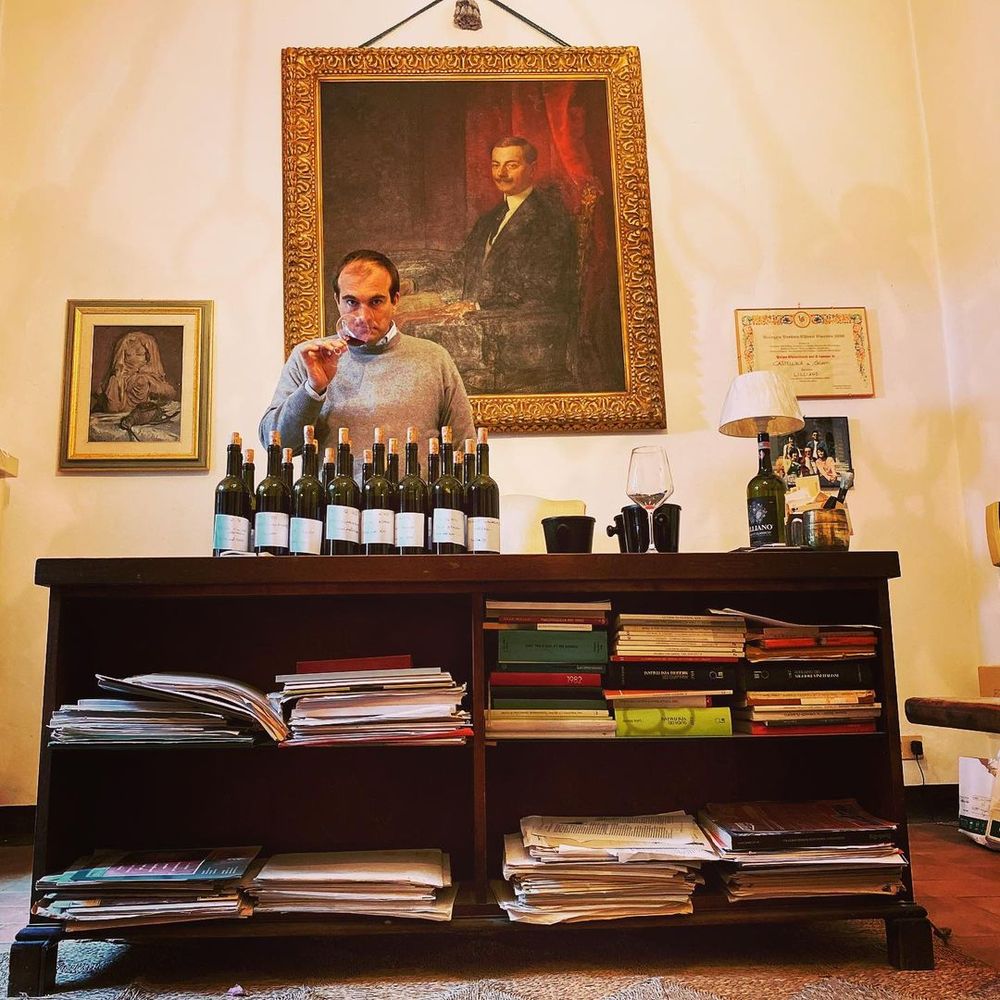
Allesandro Ruspoli from Lilliano
Lilliano in the Castellina In Chianti region
Also in Castellina In Chianti, Lilliano is a rather larger producer (150,000 bottles) owned by the Ruspoli family with links to the region that date back to the Renaissance era. Alessandro Ruspoli admits sales and production have been falling for a while along with yields; the 40 planted hectares here used to produce almost double the volume. Like many other producers the estate planted lots of new Sangiovese clones under the Chianti Classico 2000 project so quality is up, but the challenge of defining and presenting the terroir remains.
“Castellina is hard to classify – the commune has lots of different soil and altitudes, up to 600m whilst we have vineyards planted at 270-370m. We’re not as high, say, as Radda but we’re quite high, so that makes it hard to define us. Yet after the introduction of Gran Selezione, the key to going forward in Chianti Classico is increased competition between different areas and zones, to help producers stand out from one another,” he says.
He admits, however, that with the exception of Panzano – the zone famous for its big style wines – it is hard to distinguish regions by taste, whilst Gaiole In Chianti is going even further by moving towards regions within the region, or sub-sub-regions.
Ruspoli says Chianti Classico is still in some ways struggling with the legacy of the Chianti flask and chequered tablecloth which defined the wine in the 1970s and 1980s but which remains in many people’s minds.
“We’ve been able to demonstrate that Sangiovese is a great variety with lots of distinct clones that can be well adapted to different zones. In terms of going forward, this remains key to our continued success.”
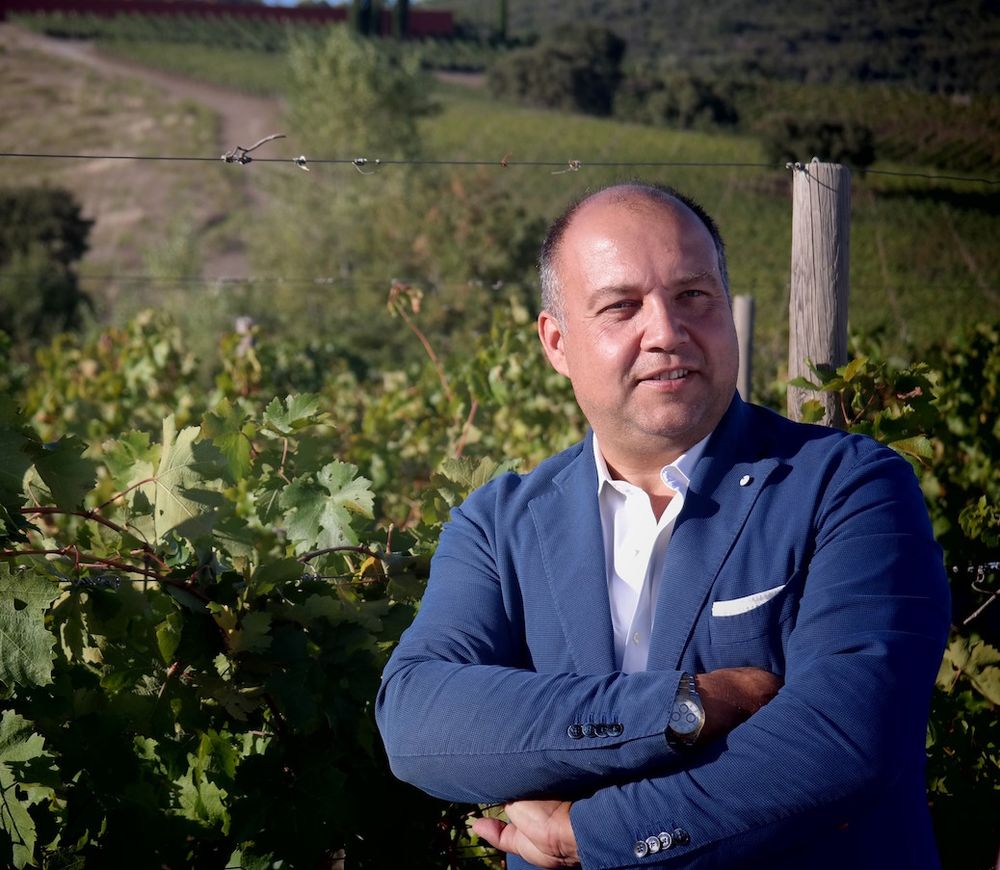
Alessandro Cellai from Vallepicciola
Vallepicciola in the Castelnuovo Berardenga region
Finally, Zooming south to nearby Siena, I reached Castelnuovo Berardenga and a new producer, Vallepicciola, whose motto is “Elegance, freshness and drinkability.”
This vast project, which produces 350,000 bottles of Chianti Classico but also Supertuscan and IGT wines with plans to increase this to 600,000, is the modern face of the region. Not bad for an outfit that started life as a hotel/restaurant with a few vines attached. Just 35% of grapes grown are Sangiovese, which sits alongside Cabernet Franc and unusually for Tuscany, Pinot Noir, planted to satisfy the Burgundian dreams of owner Bruno Bolfo, a stainless steel magnate who seems determined to turn this 15 year old project into something quite unique in the region. A brand new state of the art winery to which most estate grapes can be transported within minutes, and an extensive cellar, coupled with prodigious use of what Vallepicciola’s Alessandro Cellai says are the best Sangiovese clones – Fontanelle – have been part of this. But so is the unique location.
“We want to become one of the reference points in the Chianti Classico region and our elevation and south-facing slopes gives a great advantage, as do the fantastic soils, limestone and gallestro,” he says.
Cellai agrees that confusion has held back Chianti Classico growth.
“Consumers can go into a store and see Chianti priced between €3 and €33 – and they don’t understand why. Now Chianti is also considering introducing Gran Selezione as a category, the confusion may get worse.”
He reckons the only way Chianti Classico can properly redefine itself is through making wines that are 100% Sangiovese and that stress regionality.
“Our strategy will always be to make wines that speak of and reflect Castelnuova Berardenga, with its southerly latitude and warm climate,” he says.
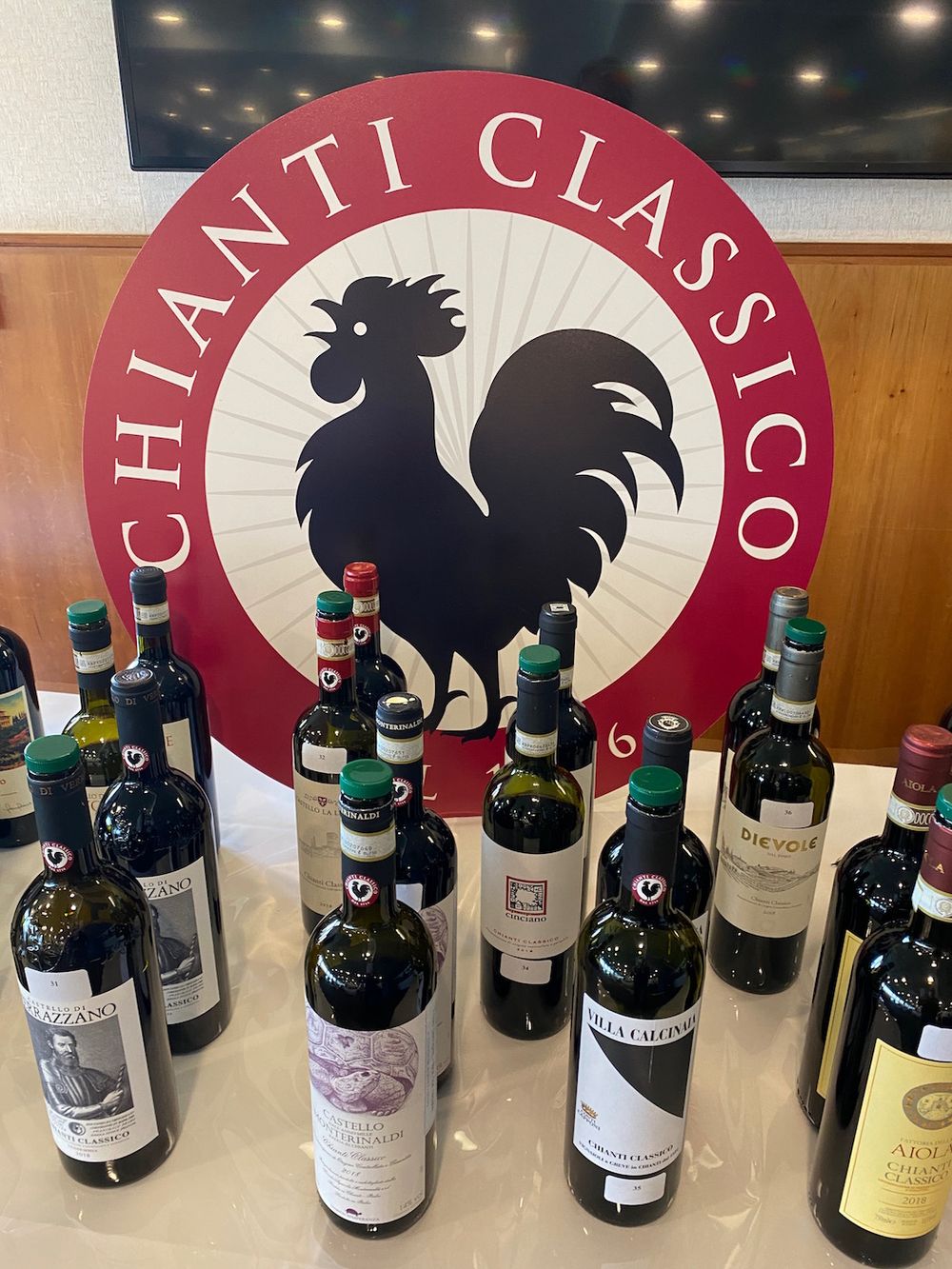
Ten Great Chianti Classicos
Greve in Chianti
Villa Calcinaia Vigna Bastingnano (Gran Selezione 2016), Vigna La Fornace (Gran Selezione 2016) and Vigna Contessa Luisa (Gran Selezione 2016). These three impressive Gran Selezione wines tasted alongside one another, demonstrate the importance of place in this key Chianti Classico commune, and what Capponi claims are the very different conditions on the left and right of the river bank. Soft and well integrated tannins allow the fruit character to play a key role in all three, which show wonderful clean but distinct spicy cherry on the palate. The Bastingnano is grown in rock and silt soil and is a firmer, more muscular wine, with lots of spice and leather; La Fornace grown in sandy soil, is smoother and shows more fruit, albeit supported by good acidity. Meanwhile Contessa Luisa is grown in clay soil which Capponi argues makes Sangiovese more intense in colour, fruitier on the nose with a more prominent tannic structure.
Castellina in Chianti
Castagnoli Terrazze Chianti Classico Riserva 2018. A great vintage for Sangiovese in this commune, this is a really well balanced Chianti Classico, lots of spice and fruit on the attack, but great length and complexity too. At 15%, it’s not shy but the alcohol is really well integrated.
Liliano Chianti Classico Riserva 2017 Ruspoli – With aromas of leather, red cherries and tobacco this Riserva is already tasting great, with wonderful texture and a long finish. Recommended.
Liliano Chianti Classico Gran Selezione 2017 Ruspoli – Complex, spicy with lots of wild aromas, with cherry and vanilla oak supporting the mid-palate. This just-released Gran Selezione is showing its youth however – a few more years and this will be a classic.
Radda in Chianti
Castelvecchi Lodolaio Riserva 2016 and Madonnino Della Pieve 2015 and 2013. These are lovely wines, textbook Chianti Classico with some austerity plenty of acidity but lots of red berry fruit that shows more fully a few days after opening. Great length.
Castelnuovo Berardenga Vallepicciola Annata 2018 and Castelnuovo Berardenga Vallepicciola Lapina Gran Selezione 2017. In many ways the Annata is the most interesting of the wines I tasted from this winery, because it shows the ambition and direction of what is likely to become an increasingly well-known producer in Chianti Classico. The 2018 is full-on, with chocolate and cherry notes on the front palate, oak clearly present but restrained, altogether a very forward style of wine. The Gran Selezione is again full-on but nuanced with warm spices coming through. Though obviously winemaking has much to do with it, it’s interesting that the southern-most commune here showed the fullest wines.
